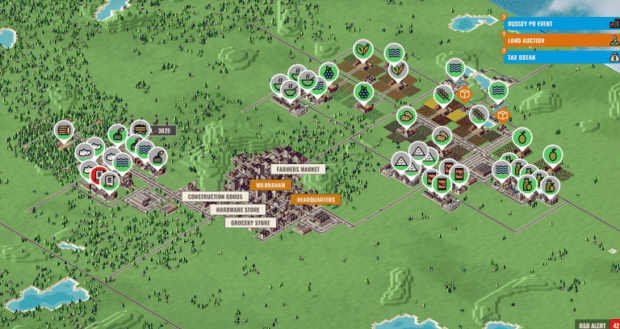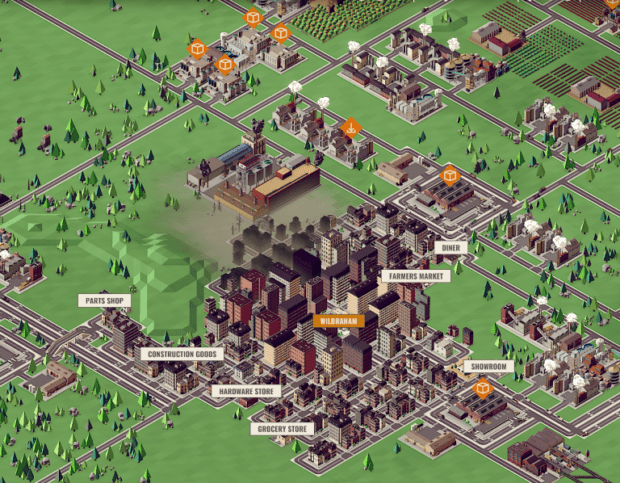Game Review: Rise of Industry – Review and Tips
Rise of Industry is probably one of the best city simulators to hit the market in quite awhile. Not because it excels at fire stations, subways or residential buildings, but precisely because it pays no attention to any of those things.

RoI focuses on the supply chain and logistics that a mega-company needs to grow … profits. You can’t make cars if you can’t make steel, rubber, glass, etc.
To win the game, the player must bring their empire to a point at which it can produce a “prototype”. Prototypes are either a car, computer or pre-made dinner. The inputs required to produce these items are multi-layered and complex. They also require the player to control more than a single region to have all the necessary resources to make everything required to produce a prototype.
Ultimately, you will either be the master of a steel (cars), petrochemical (computers) or agricultural (dinners) empire, but none of the trees is easy.
The Good
The diversity of the supply chains keeps the Overwatch Boosting game fresh through several replays. You don’t know what starting resources you’ll be given and will be forced to explore new chains.
The game stays focused on the supply chain and logistics. There are no happiness indicators, power plants, education systems or other mundane things to manage. You just stay focused on what it takes to turn wheat into a chicken dinner or coal into an engine block.
The Bad
The automatic warehousing functions sometimes clog up the works. You may need to switch warehouses from focusing on producers to focusing on retailers and back to get them to move goods the way you expect.
Trains and ships are cool, but not necessary to win the game. If you want to experience map-wide trade, build out a train network. If meeting the win conditions is your goal, you will, on most maps, only need to trade with a single neighbor and trucks/truck depots will be all you need. I have built a small train network on my last three wins, but they weren’t critical for the end game – it was just about the Benjamins. I’ve never used ships or zeppelins. Not once.
The Ugly
The stock market system seems an after-thought. Sure, it could be another way to beat the game – if buying out the last competing company actually triggered a win condition – it doesn’t. And it never really feels like the AI has any interest in buying-up anyone else. You also cannot choose to sell your own company’s stock or other stock you’ve purchased to raise funds so the valuation/devaluation of the stock is almost useless.
Some regions will end up with resources that nobody wants. It can leave you with a multi-million dollar play that is nothing more than dead money and force you to buy a neighbor’s permit early so put your headquarters in a city with some natural resources you can take advantage of.
How to Win
The goal of the game is to create a “prototype” – never lose sight of that and you are well on your way to a winning game.
Study your starting region:
What resources are available in your region and the closest 2 regions. You have to immediately take advantage of your region’s resources and be ready to buy a permit from your neighbor if their’s are also useful.
What shops does your starting city have? Those copper resource nodes won’t be any good if you only have a farmer’s market, hardware store and construction goods shops that don’t buy raw copper or the tier one production goods that come from it.
While you can go crazy and trade with every city on the map, but it isn’t necessary and paying for the extraneous logistics will slow your race to the finish.
Develop Raw/Farm Resources First
Develop agriculture and raw resource gatherers/farms/etc for resources at the top of your home town’s shops demand list. Get raw/farm resources selling immediately and directly to the shops so that your company is profitable before you run out of the money from your startup loan. Do not use warehouses during this phase of the game, you’ll run out of money. Let the gatherer/farm trucks take products all the way to market.
Be Ready to Buy Your Neighbor
It will cost between $6 and $9 million to buy a permit to build in another city. When that close-by neighbor with all the awesome resources puts his permit up for bid. Take out a loan to buy it, win the auction and immediately develop the raw resources that his home shops will buy. This will cover the loan payments while you create a value chain to produce higher tier items for sale and to progress towards your chosen prototype.
You may have to increase the term of the loan to make the payments affordable. Take whatever ridiculous interest rate is required to keep the payments within what you can immediately make from the resources available at the new town. You should refinance this loan once you’ve developed the new town’s value chain and can afford a shorter loan with better terms.
Choose a Prototype
Will your city or cities be focused on building automobiles, computers or pre-made dinners? Each of the three available prototypes requires a broad and deep supply chain before you can feed the appropriate mega-factory to build one. You will have to research some things you will never be able to sell, but don’t make them until you have to. Produce and sell all the goods you can that build up your supply chain for the prototype. As your city grows, choose the right shops to give you somewhere close to sell those wares.
This is where you will need to consider warehouses, truck depots and perhaps trains.
If you choose the dinner protoype, farmer’s market->grocery store->diner will be in your city’s future. For the computer, the hardware store->ironmongery->home goods stores will help you maintain a profit while getting to the goal line. For the car prototype, the hardware store->construction goods -> parts shop line will prepare you for the final push to the finish line.
The last store you’ll need to reach the end is the showroom. This shop only sells the prototypes and sells them for a lot of money. Once you have a way to produce all of the prerequisites for your prototype, make sure you have a showroom, build the appropriate mega-factory and the win is yours.

Building your prototype will not come fast. It takes 6 months for each of the components and an entire year for the mega-factory to complete a single prototype.






